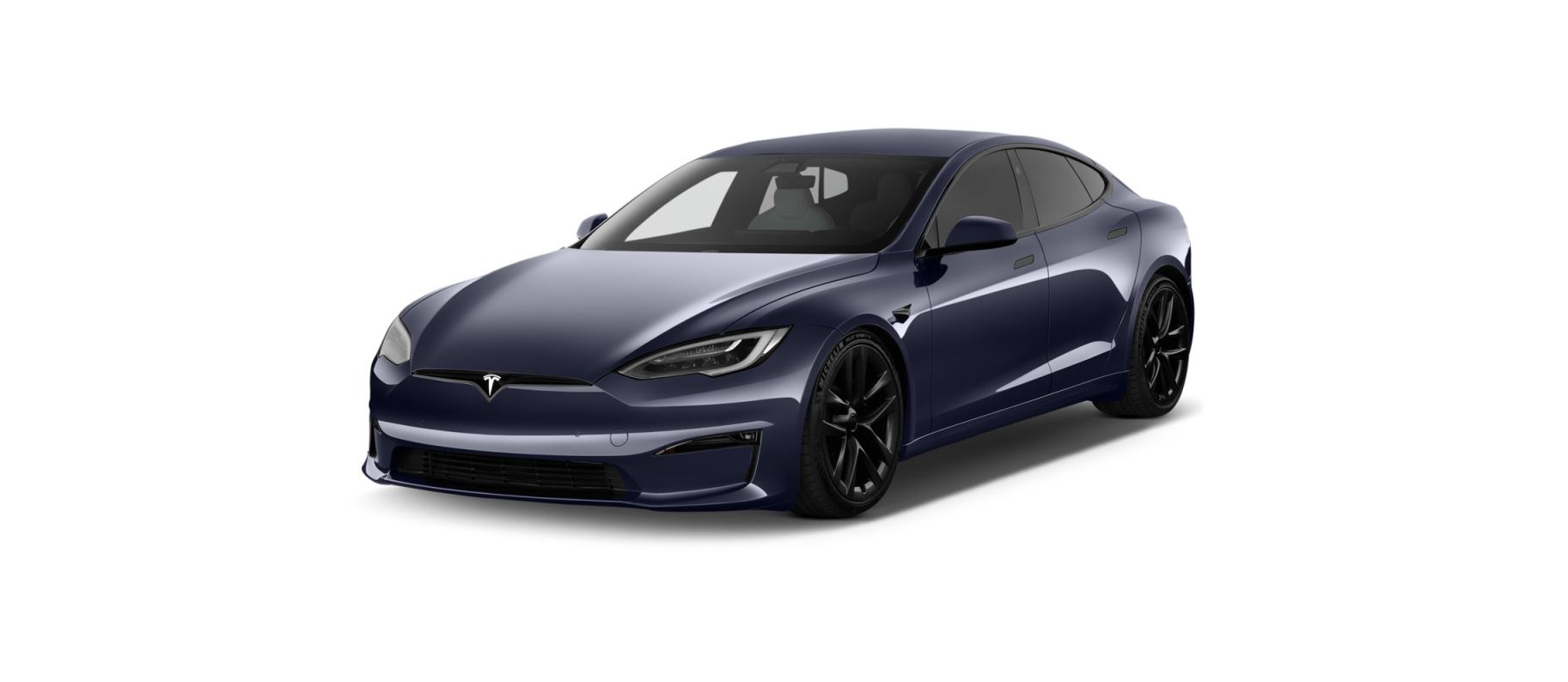2021 Tesla Model S Climate Controls
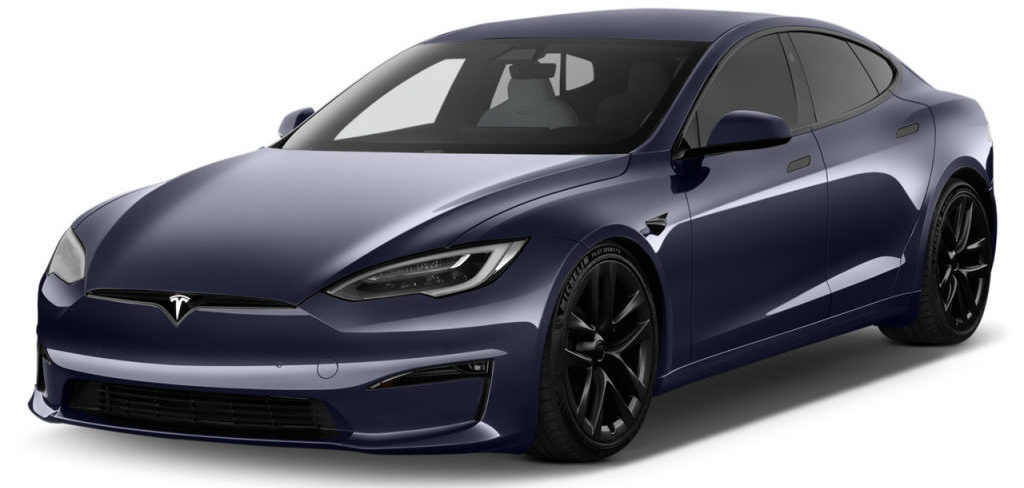
Overview of Climate Controls
Climate controls are available at the bottom of the touchscreen. By default, climate control is set to Auto, which maintains optimum comfort in all but the most severe weather conditions. When you adjust the cabin temperature while in the Auto setting, the system automatically adjusts the heating, air conditioning, air distribution, and fan speed to maintain the cabin at your selected temperature. Touch the display temperature at the bottom of the touchscreen to access the main climate controls screen, where you can adjust your climate preferences. You can revert back to Auto at any time by touching Auto. Touch the power button on the main climate controls screen to toggle on or off. For quick access to common controls, touch < or > to display the climate popup.
Adjusting Climate Control Settings
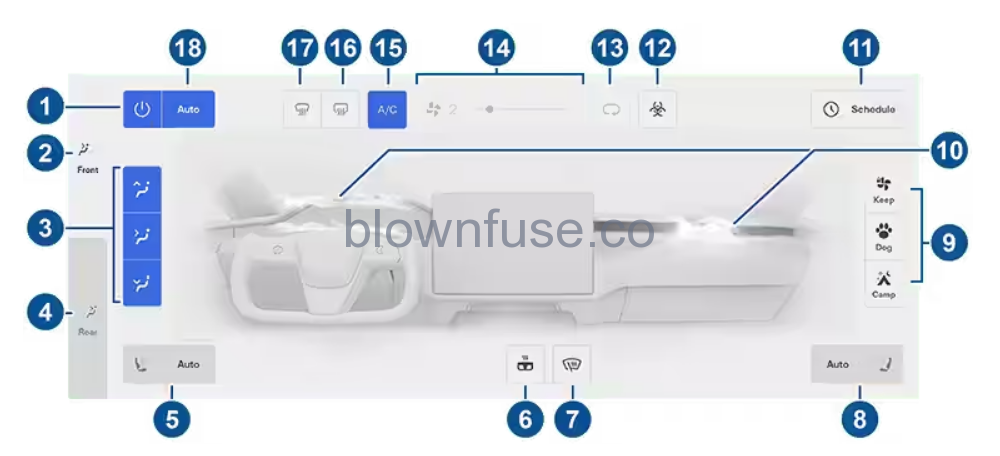
- Touch to turn the climate control system on or off.
- Touch to adjust the climate settings for the front cabin.
- Choose where air flows into the front cabin (windshield, face-level, or foot-level vents). You can choose more than one location.
NoteWhen air is directed to the foot-level vents, air continues to flow to the windshield vents to assist in defogging. When air is directed to the face-level vents, air does not flow to the windshield.
- Touch to adjust the climate settings for the rear cabin. Passengers seated in the rear cabin can use the rear touchscreen to turn the rear fan on and off, adjust seat heaters, and control how air flows from the rear vents.
- Touch the driver’s side seat icon to adjust seat heaters for the driver. The seat operates at three levels from 3 (highest) to 1 (lowest). The seat icon displays twisting lines that turn red (heating) or blue (cooling) corresponding with the set level. Auto, which displays when the climate control system is set to Auto, warms or cools the front seats based on cabin temperature. For one-touch access to seat heaters, you can add them to the touchscreen’s bottom bar (see Customizing My Apps).
- Touch to turn on the heated steering yoke.
- Touch to turn on the wiper defrosters. Wipers defrost for 15 minutes then turn off automatically.
- Touch the passenger’s side seat icon to adjust seat heaters for the front passenger. The seat operates at three levels from 3 (highest) to 1 (lowest). The seat icon displays twisting lines that turn red (heating) or blue (cooling) to corresponding with the set level. Auto, which displays when the climate control system is set to Auto, warms or cools the front seats based on cabin temperature. For one-touch access to seat heaters, you can add them to the touchscreen’s bottom bar (see Customizing My Apps).
- When in Park, these settings display to allow you to keep the climate control system operating, even when you leave Model S (see Keep Climate On, Dog, and Camp).
- Touch to adjust how air flows from the front vents. See Adjusting the Front and Rear Vents.
- When Model S is in Park, touch Schedule to set a recurring daily time when you want Model S to be ready to drive by preconditioning the Battery and cabin climate and/or charging during off-peak hours (see Scheduled Charging and Scheduled Departure).
- If your Model S is equipped with the medical-grade HEPA (High Efficiency Particulate Air) filter, this filter ensures the best quality air inside the cabin whenever the climate control system is on and outside air is entering the cabin (recirculate is off). The HEPA filter is extremely effective at removing particles, including pollution, allergens, bacteria, pollen, mold spores, and viruses. Both the HEPA filter and the secondary filtration system also contain activated carbon to remove a broad spectrum of odors and gases. When you engage Bioweapon Defense Mode, the positive pressure inside the cabin minimizes the amount of outside air that can enter the vehicle.
NoteSome gases, such as carbon monoxide, are not effectively removed by activated carbon.
- Touch to control the flow of air inside the cabin. Air can be drawn into Model S from outside or air can be recirculated inside the cabin.
- Use the slider to adjust the fan speed.
NoteAdjusting the fan speed may change the selected setting for how air is drawn into Model S in order to increase or reduce air flow.
- Touch to turn the air conditioning system on or off. Turning it off reduces cooling, but saves energy.
NoteBecause Model S runs much quieter than a gasoline-powered vehicle, you may notice the sound of the air conditioning compressor as it is operating. To minimize noise, reduce the fan speed.
- Touch to warm up the rear windshield. When operating, the icon turns red. After 15 minutes, the rear window defroster automatically turns off. The exterior side mirrors are also heated whenever the rear window defroster is operating.
- The windshield defroster distributes air flow to the windshield. Touch once to defog the windshield (the icon turns blue) (the icon turns yellow). Touch a second time to defrost the windshield (the icon turns red and the heating and fan operate at maximum levels). Touch a third time to turn off and restore the air distribution, heating, and fan to their previous settings. In cold ambient temperatures, the exterior side mirrors are also heated whenever the windshield defroster is operating. See Cold Weather Best Practices for more information on preparing for cold weather.
- Touch Auto to turn the Auto setting on or off.
Climate Popup
Touch the temperature arrows on the bottom of the touchscreen to display a popup for easy access to some of the most common climate controls: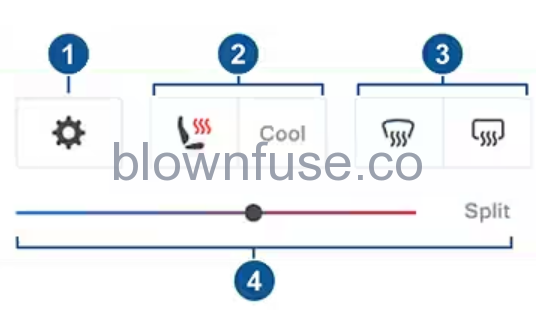
- Touch to access the main climate controls screen.
- Enable or disable heated or cooling seats.
- Enable or disable the front or rear windshield defrosters.
- Modify the cabin temperature by dragging along the slider. You can also enable temperature splitting which allows the driver and front passenger to customize their own climate preferences. The front passenger can touch the temperature icon on the bottom of the touchscreen or the main climate controls screen to adjust. Touch Split again to disable climate splitting.
Adjusting the Front and Rear Vents
Model S has a unique horizontal face-level vent that spans the width of the dashboard. It also has vents at the top and bottom of the rear console.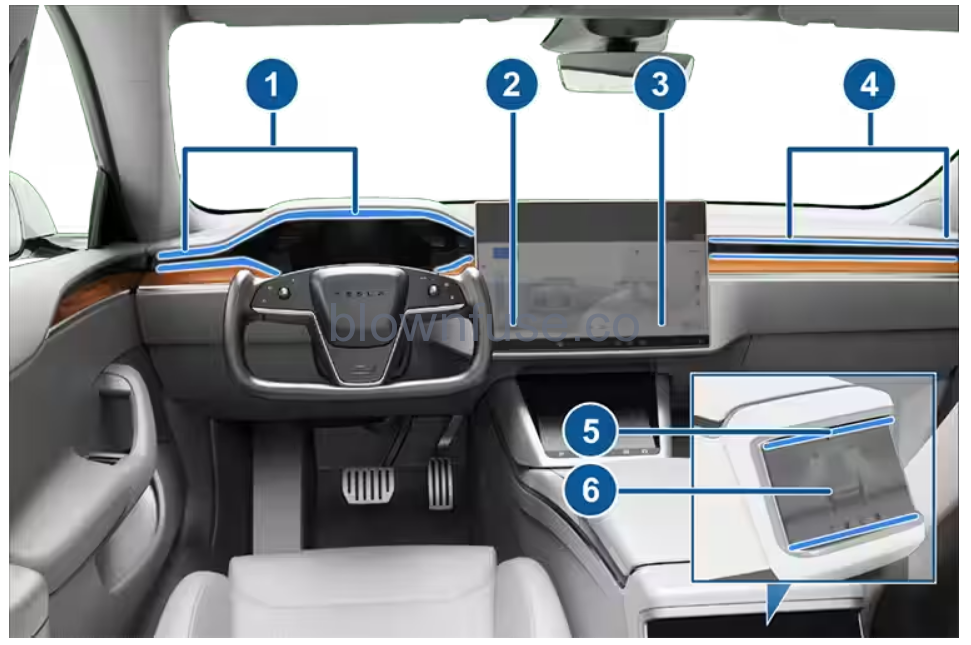
- Driver vents
- Driver controls
- Passenger controls
- Passenger vents
- Rear vents
- Rear controls
Using the touchscreens, you can pinpoint exactly where you want to direct the air flowing from this vent when heating or cooling the cabin. When the face-level vent is on you can adjust the direction of the air flow from each vent. To adjust the direction of the air flow, touch the radiating air waves from the corresponding vent on the touchscreen. The air flows in a single stream when centered or splits into mirrored air streams when air is directed outward or inward from the center of the vent.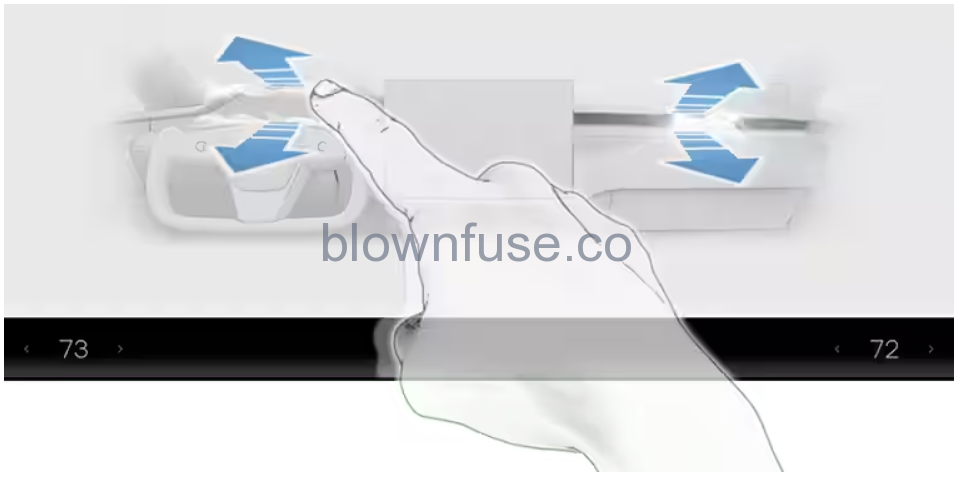
Keep Climate On, Dog, and Camp
The Keep Climate On, Dog, and Camp settings allow you to keep the climate control system running when in Park, even after you’ve left Model S or choose to stay inside the vehicle. These settings are useful when it is important to maintain the cabin temperature in hot or cold weather conditions. For example, when leaving groceries in Model S on hot days, you may want to use Keep Climate On to prevent spoilage.
Dog is designed to maintain a comfortable cabin temperature for your pet while you actively and frequently monitor this temperature using the mobile app (which requires both your phone and the vehicle to have cellular connectivity). When in Dog, the touchscreen displays the current cabin temperature to inform people passing by that your pet is safe. This setting is not intended for people, and should only be used for short periods of time while you stay in close proximity should you need to return to the vehicle in situations where the temperature can no longer be maintained.
Camp allows you to power electronics through the USB ports and low voltage outlet in addition to maintaining the cabin temperature. The touchscreen remains on so you can play music, browse the internet, play games in the arcade, or watch shows in Tesla Theater. You can also control media and climate settings from a paired phone. Camp is ideal for remaining inside your vehicle, such as camping or staying with a child. While active, Sentry Mode and the vehicle alarm system are disabled.
To operate Keep Climate On, Dog, or Camp:
- Make sure the Battery’s charge level is at least 20%.
- Engage Park. The Keep Climate On, Dog, and Camp settings are available only when Model S is in Park.
- If necessary, adjust the climate settings.
- On the climate controls screen, touch Keep Climate On, Dog, or Camp.
NoteYou can also control Dog and Camp from the mobile app, by swiping up the gray bar on the Climate screen.
The climate control system attempts to maintain your climate settings until you shift out of Park or manually turn it off. Avoid using Keep Climate On, Dog, or Camp when the battery charge is low. If the Battery’s charge level drops below 20%, the Tesla mobile app attempts to repeatedly send you notifications reminding you to check on anything that you have left in Model S.
Cabin Air Filter(s)
Model S has one or more air filters to prevent pollen, industrial fallout, road dust and other particles from entering through the vents.
Cabin Overheat Protection
The climate control system can reduce the temperature of the cabin in extremely hot ambient conditions for a period of up to twelve hours after you exit Model S. Touch and choose:
- Off: Disable Cabin Overheat Protection.
- On: The air conditioning operates when the cabin temperature exceeds 105° F (40° C).
Climate Control Operating Tips
- When you use the mobile app to turn on the climate control system, it automatically turns off after four hours or if the charge level drops to 20%. To cool or heat the cabin for a longer period, you must turn it on again.
- If the climate control system is louder than you prefer, manually reduce the fan speed.
- In addition to cooling the interior, the air conditioning compressor also cools the Battery. Therefore, in hot weather, the air conditioning compressor can turn on even if you turned it off. This is normal because the system’s priority is to cool the battery to ensure it stays within an optimum temperature range to support longevity and optimum performance.
- Even when not in use, you may hear Model S emit a whining noise or the sound of water circulating. These sounds are normal and occur when the internal cooling systems turn on to support various vehicle functions, such as maintaining the low voltage battery and balancing the temperature of the high voltage Battery.
- To ensure the climate control system operates efficiently, close all windows and ensure that the exterior grille in front of the windshield is free of ice, snow, leaves, and other debris.
- In very humid conditions, it is normal for the windshield to fog slightly when you first turn on the air conditioning.
- It is normal for a small pool of water to form under Model S when parked. Extra water produced by the dehumidifying process is drained underneath.
- To reduce the temperature in the cabin in hot weather conditions, the fan may turn on to vent the cabin when the vehicle is parked. This occurs only if the battery’s charge level is above 20%.
